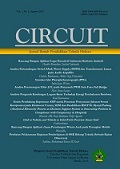PENGGUNAAN FESTO FLUIDSIM SEBAGAI MEDIA PEMBELAJARAN UNTUK MENINGKATKAN HASIL BELAJAR SISWA KELAS X PELAJARAN DASAR LISTRIK DAN ELEKTRONIKA DI SMK NEGERI 2 BANDA ACEH
DOI:
https://doi.org/10.22373/crc.v3i2.5160Keywords:
, instructional media, festo fluidsim, outcome learningAbstract
Festo Fluidsim is a computer-based learning media that can be used to facilitate students in
understanding learning methods. Festo Fluidsim is an application for making basic electronic circuits,
then followed by pneumatic and electro-pneumatic circuits that can be directly simulated. The media
is suitable for use as a learning medium to help improve the learning outcomes of students majoring
in industrial electronics engineering who are studying the basic subjects of electricity and electronics
at SMK Negeri 2 Banda Aceh. The type of this research is a quantitative study using the experimental
method, forming 2 study groups, control and subsequent experiments conducted data collection with
the test method. The results obtained indicate an increase in the value of learning outcomes from an
average pretest 46.19 to an average at 88.21 posttest. Similarly, based on the results of statistical tests
conducted, obtained an average value of N-Gain 0.79 <0.7 which can be categorized as high, the results
of the criteria of pretest significance value 0.13> 0.05 and posttest significance value 0.59> 0 , 05
which is normally distributed, and subsequently gets a Sig. (2-tailed) score is 0,000 which is smaller
than 0.05, so it can be concluded that the use of Festo Fluidsim as a learning medium can effectively
improve student X learning outcomes of Elementary subjects Electricity and Electronics SMK Negeri
2 Banda Aceh
Downloads
Published
Issue
Section
License
Authors who publish in CIRCUIT: Jurnal Ilmiah Pendidikan Teknik Elektro agree to the following terms:
- Authors retain copyright and grant the journal right of first publication with the work licensed under a Creative Commons Attribution-ShareAlike 4.0 International License (CC BY-SA 4.0) that allows others to share and adapt the work with an acknowledgement of the authorship and initial publication in this journal
- Authors are able to enter into separate, additional contractual arrangements for the non-exclusive distribution of the journal's published version of the work (e.g., post it to an institutional repository or publish it in a book), with an acknowledgment of its initial publication in this journal.
- Authors are permitted and encouraged to post their work online (e.g., in institutional repositories or on their website) prior to and during the submission process, as it can lead to productive exchanges, as well as earlier and greater citation of published work. (See The Effect of Open Acces)

